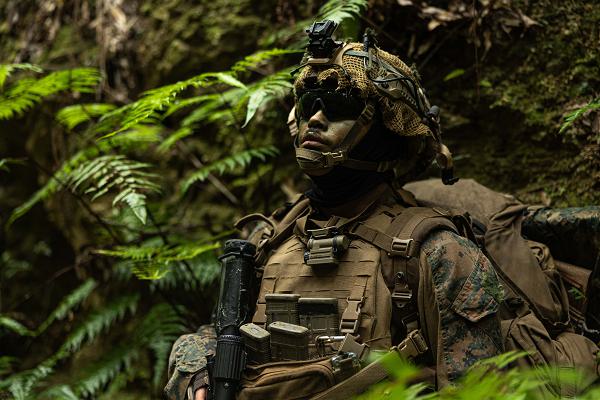
Camp Hansen, Okinawa, Japan. (February 10, 2024): What is one of the most powerful weapons on the battlefield but doesn’t fire a thing? Camouflage. In the photo above, Lance Cpl. Alexander Moralesgarcia conducts a patrol during the 3rd Marine Division’s annual Squad Competition. This Marine is concealing his presence using a variety of camouflage methods that have been evolving since World War I.
In the early annals of warfare, individual troops did not spend much time on personal concealment as most battles were fought in large columns or in the trenches. It wasn’t until World War I and the invention of the airplane that military units began to concern themselves with shielding their location from above.
The first crude attempts at employing camouflage to confuse the enemy began with the Navy and the “razzle dazzle” design. These zebra-like patterns were emblazoned on American ships, not to conceal but rather to confuse enemy gunners. The design’s optical effect made it impossible for enemy gunners to get an accurate “fix” on a target’s range, speed, and heading which undoubtedly saved thousands of allied lives.
The use of camouflage by individuals on themselves and their equipment really expanded in the jungles and deserts during World War II. The goal of individual concealment centers on applying colors and distinctive shapes to break up the pattern of the human form or the straight lines of equipment and weapons.
The face-paint worn by the Marine above looks randomly applied but it actually follows a carefully researched process designed to deceive the human eye. This is done through “countershading” or preventing the casting of a shadow. The military also uses “mimicry” to make military vehicles appear to look like something they are not. This tactic was famously used against the Germans when the allies created “dummy” divisions that were supposedly to be led by General George Patton. The deception worked and undoubtedly saves thousands of lives on D-Day.
Camouflage techniques have evolved over the years to adapt to modern warfare. Today, there are paints designed to fool infrared sensors and textiles attached to vehicles that absorb probing radars. The most advanced technologies are now employed to create “stealthy” ships and planes which are nearly invisible to enemy radar and further advances in stealth technology are expected. On the horizon, the military is studying ways to defeat advanced sensors including the development of modern multi-spectral camouflage which dissipates not only visible light but also near infrared, short-wave infrared, radar, ultraviolet, and thermal imaging.
All these concealment methods are a powerful tool to deny the enemy knowledge of a unit’s location, disposition, and intentions. And it doesn’t fire a shot.


